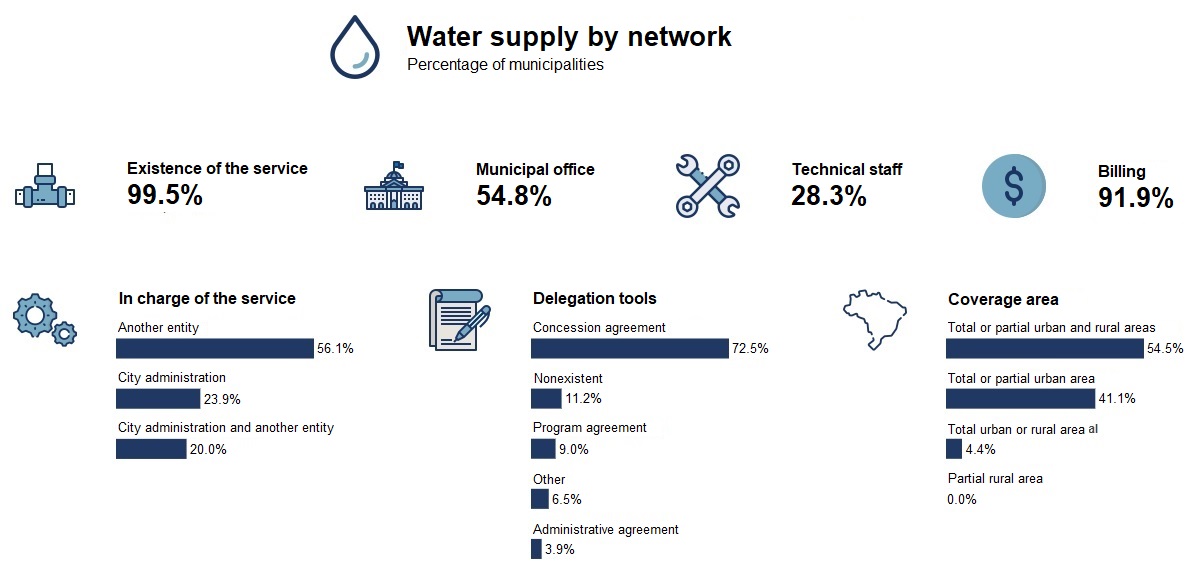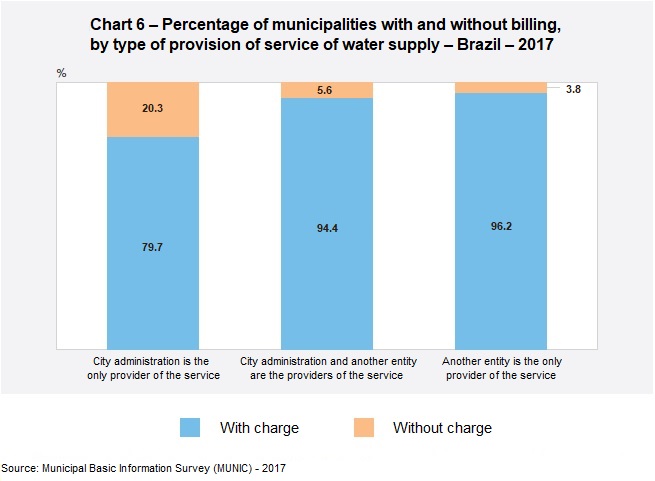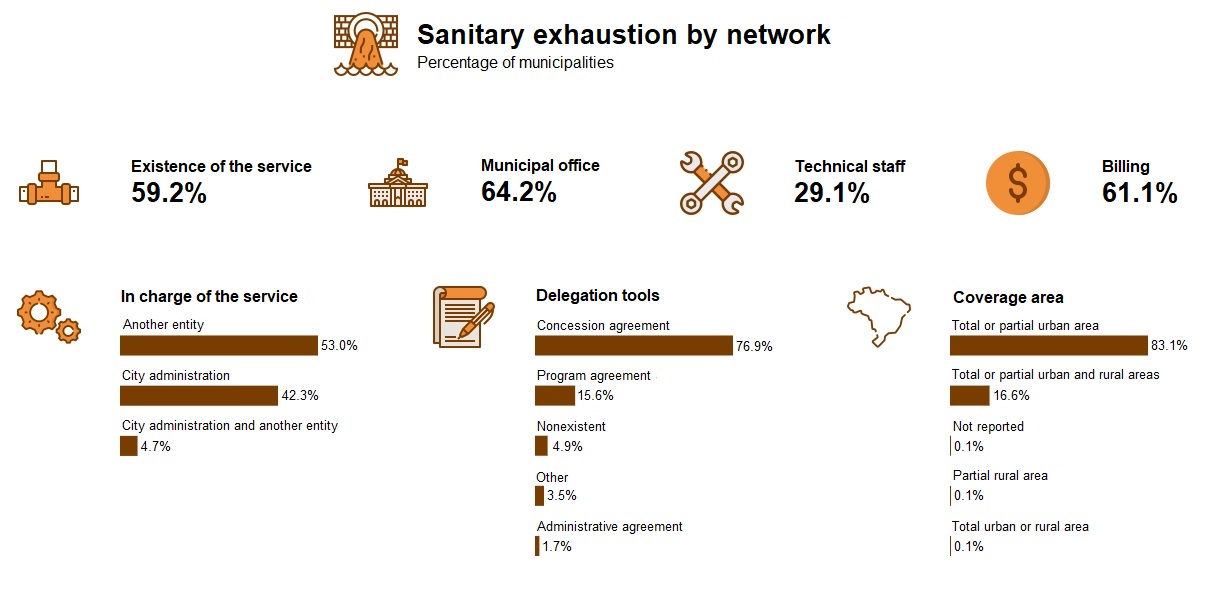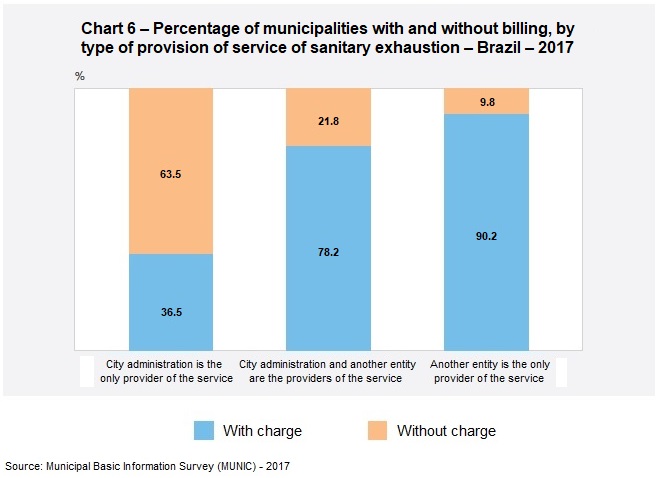MUNIC 2017: Less than half (44.7%) of municipalities with water supplied by network have laws protecting springs
July 22, 2020 10h00 AM | Last Updated: July 27, 2020 03h02 PM
In 2017, less than half (44.7% or 2,476) of the 5,544 municipalities with water supplied by a general network had laws protecting springs, while 63.9% (3,544) had a legislation that required approval for implementing water supply systems in new allotments. As to surveillance, 64.7% (3,588) of the municipalities had a municipal office in charge of monitoring water quality. In 14.3% (794) of the municipalities with a general network did not count on a legislation nor an office in charge of monitoring water quality.
Among the 3,299 municipalities with sanitary exhaustion in 2017, 61.6% (2,032) of them counted on surveillance to implement systems in new allotments, surpassing 80% in the localities with more than 50 thousand inhabitants. The proportion of municipalities with surveillance was lower in the North (32.8%) and Northeast (41.4%), whereas it reached its highest in the South (71.3%).
54.8% (3,039) of the municipalities with water supply counted on an organizational structure to manage these services, being that in 2,509 of them the structure was linked to the direct administration and, in 530, to the indirect administration. 2,504 municipalities did not count on a municipal office to manage these services. Exclusive secretariats were available in only 2.9% (89) of the municipalities, whereas they were combined structures (works, environment, development, etc.) in 71.8% (2,182), in 7.8% (238) they were directly subordinate to the mayor, and in 17.5% (530) they belonged to the indirect administration.
64.2% (2,118) of the municipalities with sanitary exhaustion counted on an organizational structure to manage these services, being that the structures were linked to the direct administration in 1,757 of them, and to the indirect administration in 361 of them. Only 3.6% (76) of the municipalities had an exclusive secretariat, in 72.2% (1,528) the management was combined with other policies, in 7.2% (153) they were subordinate to the mayor, and in 17% (361) they belonged to the indirect administration.
In 2017, only 28.4% (1,575) of the 5,544 municipalities with water supply network had a technical staff working in this area. Among the 3,299 municipalities with sanitary exhaustion through a collecting network, 29.1% (961) had a technical staff.
Among the municipalities with water supplied by a general network, the municipal administration implemented the service in 43.9% (2,432) of them, being the only player in 1,326 and sharing the implementation with other entities in 1,106. In the remaining 3,112 (56.1%) municipalities, the implementation was done by other entities, without any participation of the municipal administration. Among the municipalities with sanitary exhaustion, the municipal administration implemented the service on its own in 53% (1,748) of the municipalities, while the implementation was shared in 156 (4.7%), and in charge of other entities in 42.3% (1,395).
Concerning billing, 91.9% (5,094) of the municipalities with water supplied by a network charged for their service, whereas 61.1% (2,017) charged for sanitary exhaustion.
The data are from the Municipal Basic Information Survey (MUNIC) - Sanitation Supplement - 2017. The complete publication and tables are available on the right side of this page.

Of the 26 municipalities without water supply, 15 are in the Northeast
Of the 5,570 Brazilian municipalities, 5,544 (99.5%) reported the existence of water supplied by a general network. Among the Major Regions, the highest rate was in the Southeast (100%), whereas the lowest one was in the North (98.2%). In the division among the classes of population size, the three highest ranges (municipalities with more than 50 thousand inhabitants) had the highest rate, 100%, while those between 5 and 10 thousand inhabitants had the lowest one, 99%.
Of the 26 municipalities without this service, 15 were in the Northeast, being five in Paraíba, four in Piauí, two in Maranhão and one in Rio Grande do Norte, Pernambuco, Alagoas and Bahia. Eight were in the North, being six in Pará, one in Rondônia and one in Amazonas. They were two in the Central-West, both in Mato Grosso. And only one municipality in the South, in Rio Grande do Sul.
Among the 5,444 municipalities with water supply network, 3,039 (54.8%) counted on an organizational structure to manage this service. Of them, the structure was linked with the direct administration in 2,509 of them and, in the other 530, with the indirect administration (most of them independent municipal services or departments of water and sewage). A total of 2,504 municipalities did not have any municipal office to manage the water supply service. The municipality of Rio de Janeiro did not inform the requirements of the organizational structure to manage this service.
Concerning the classes of population size, more than 60% of the municipalities with more than 20 thousand inhabitants reported to have a municipal office in charge of managing this service, reaching 71.4% of those with more than 500 thousand inhabitants.
In relation to the regions, the Northeast had the highest percentage of municipalities with this structure, 59.3%. The lowest percentage was in the Central-West, 44.7%.
Only 2.9% of the municipalities have exclusive secretariats for water supply
Concerning the characterization of the structures, 2.9% (89) of the municipalities counted on exclusive secretariats. 71.8% (2,182) counted on combined structures (secretariats combined with other policies and sectors subordinate to other secretariats, respectively, 18.6% and 53.2%). 7.8% (238) counted on sectors directly subordinate to the municipal administration and 17.5% (530) counted on offices of the indirect administration.
Among the 2,182 municipalities with shared policies, 1,616 were as sectors subordinate to other secretariats and 566, as secretariats combined with other policies. With 1,082 municipalities, works was the most frequent secretariat, followed by environment, with 418. They were followed by health (209), urban development (121), planning (103) and housing (49).
Among the municipalities with water supplied by a general network, 28.4% (1,575) counted on a technical staff working in the area. Comparing the Major Regions, the highlights were Central-West and Northeast, which registered the highest percentages, 30.1% and 30%, respectively.
In the universe of the municipalities with a municipal office in charge of managing the service of water supply, those with an exclusive secretariat and with an office in the indirect administration were also those that mostly had a technical staff working in the area: 77.5% of the municipalities with exclusive secretariat and 68.7% of those with an office in the indirect administration had technical staffs. On the other hand, there were the municipalities that did not have any municipal office in charge of managing the service of water supply (2,504), of which only 7.9% counted on technical staffs.
The survey also dealt with the municipal legislation related to water supply: protection to springs and requirement of approval for the implementation of a system of water supply in new allotments, and surveillance of water quality. 2,476 municipalities (44.7%) counted on laws protecting the springs, whereas 3,544 (63.9%) reported the existence of legislation requiring approval of the implementation of a system of water supply in new allotments. 3,588 (64.7%) municipalities counted on municipal offices in charge of surveilling water quality.
City administrations are not responsible for water supply in 56.1% of the municipalities
Among the 5,544 municipalities where the city administrations reported the existence of a service of water supply through a general network, the city administrations themselves carried out the service in 2,432 (43.9%) of them, the city administrations were the only performer in 1,326, and they shared the implementation with other entities in other 1,106. In other 3,112 (56.1%), other entities were in charge of the implementation, without any participation of the city administrations.
The Northeast stood out in this issue, as it was the region with the highest percentage of municipalities where the city administrations implemented the service, either as a single performer or together with other entities.
Among the 3,039 municipalities that had municipal offices managing the service of water supply, in 68.4% (2,079) the city administrations implemented the service, either as a single performer (40.4%) or together with other entities (28%). In the other 31.6% (960), other entities implemented the service without any participation of the city administrations.
In the 2,505 municipalities that did not have any municipal office in charge of the service, other entities implemented the service in 85.9% (2,152) of them and the city administrations were one of the performers of the service in 14.1% (353) - either as the single performer (3.9%) or together with other entities (10.2%).
In the comparison with other states, all the municipalities of Roraima reported to have the service implemented by other entities but the city administrations. This percentage was higher than 90% in Acre and Tocantins, 90.9% and 91.4%, respectively. In contrast, Amazonas and Mato Grosso revealed high rates of municipalities where the service was implemented by the city administrations only, 80.3% and 73.4%, respectively.
11.2% of the municipalities do not have tools to delegate the service
If the implementation of the service of water supply is not under the responsibility of the city administration, a tool to delegate the provision of the service should be available in three modalities: program agreement, concession agreement or administrative agreement (to a civil or community association).
Of the 4,218 municipalities where there were players other than the city administrations, the most frequent tool used was the concession agreement, in 3,059 municipalities. Other 381 municipalities reported the existence of program agreements, a modality that is concentrated in the Southeast and South, in São Paulo and Rio Grande do Sul, where they reach 35.4% and 20.3% of the municipalities, respectively.
Administrative agreements appeared less frequently, in 3.9% (165), mainly in the Northeast and South, in the states of Ceará (12.2%), Piauí (9.1%) and Rio Grande do Sul (10.7%).
11.2% (471) of the municipalities did not count on delegation tools, being 325 in the Northeast, where the rate hit 21.7%, and 56 in the North, with a rate of 18%. Other 273 reported the existence of tools other than the three established in the legislation.
Billing is less frequent where city administrations provide the service of water supply
Of the 5,544 municipalities supplied by water, 450 of them (8.1%) did not bill for the service of water supply. The lack of billing was most found among the municipalities in the lower class of population size: 9.7% among the municipalities with up to 5 thousand inhabitants. On the other hand, all the municipalities with more than 500 thousand inhabitants billed.
In regional terms, the North Region recorded the highest frequency of free-of-charge municipalities, 15.6%, whereas the South posted only 3%. If we consider the municipalities by type of provision of the service of water supply, the lack of billing was most found in the municipalities where city administrations were the only providers of the service (20.3%). Conversely, where the city administration and other entity or only another entity was in charge of the service, the percentages of free-of-charge municipalities in the supply were quite lower: 5.6% and 3.8%, respectively.

49.2% of the population suffers with intermittence or rationing of water supply
A group of 2,319 municipalities (41.8% of those that reported the existence of the service of water supply) registered internittence or rationing in the water supply over the last 12 months before the survey.
Together, these municipalities comprised 49.2% of the Brazilian population, according to the population estimated in 2017. The occurrence of intermittence or rationing recorded a wide regional variation, reaching 65.7% in the Northeast and 21.9% in the South.
Among these 2,319 municipalities, the intermittence or rationing was constant in 540 (23.3%), regardless of the time of the year. In 307 (13.2%), the intermittence or rationing occurred every year, at the same time. In the remaining 1,472 (63.5%), the occurrence of intermittence or rationing was irregular.
The states of Mato Grosso do Sul, Paraná and São Paulo were those that reported the lowest frequency of municipalities with intermittence or rationing, 15.2%, 16% and 17.7%, respectively, most of them in an irregular way.
Among the reasons, the highlights were drought, registered in 1,029 (representing 44.4% of all the municipalities with intermittence or rationing); deficiency in water distribution, registered in 984 (42.4%) municipalities; and lack of water in the springs, an answer found in 869 (37.5%) municipalities. Other less frequent reasons: deficiency in the production of water, in 500 (21.6%) municipalities; and floating population, recorded in 94 (4%) municipalities.
Concerning the existence of records of households using alternative solutions, of the 5,544 municipalities supplied by water, 4,690 (84.6%) reported not having records of such households, though they knew their existence, and only 599 (10.8%) municipalities reported to have such records.
Only 4.4% of the municipalities have total coverage of water supply
Among all the municipalities with the service of water supply, 3,263 (58.9%) reported to have a network in the urban and rural areas (either totally or partially), being that in only 4.4% (242 municipalities that comprised 2.6% of the Brazilian population, according to the population estimated in 2017) the general network of water distribution was available in the entire area.
Other 2,279 (41.1%) reported that the network was available in the entire or in part of the urban area. Only two municipalities reported that the network was available only in part of the rural area.
Southeast has six times more municipalities with sanitary exhaustion than the North
Of the 5,570 Brazilian municipalities, 3,299 (59.2%) reported the existence of a service of sanitary exhaustion though a sewage collecting network. In the comparison among the classes of population size, the higher the class, the bigger is the existence of a network. Only 44% (543) of the municipalities with up to 5 thousand inhabitants counted on sewage collecting networks, while it reached 97.6% (41) in the municipalities with more than 500 thousand inhabitants.

The difference was also big in the comparison among regions. In the Southeast, nearly 96.5% (1,609) of the municipalities counted on sewage networks, at least in part of their territories; in the North, they were only 14.9% (67). In the Northeast, slightly more than half of the municipalities reported to have exhaustion through networks and the other regions did not count on sanitary exhaustion through networks in more than 50% of the municipalities.
In Espírito Santo and São Paulo, 100% of the municipalities reported the existence of the service, whereas the lowest percentage was in Maranhão, only 6.5%.
In the 3,299 municipalities that reported the existence of this service, 2,118 (64.2%) reported to have the organizational structures to manage the services, being that the structure was linked to the direct administration in 1,757 of them, and to the indirect administration in 361 of them (most of them were independent municipal services or departments of water and sewage).
In the comparison among the regions, the Central-West registered the lowest percentage of municipalities with this structure, 42.6%. The highest one was in the Northeast, with 70.9%.
Among those with structures to manage sanitary exhaustion, in 55% of them the managing office was subordinate to other secretariats, while the management was through secretariats coupled with other policies in 17.2% of them and, in 7.2%, the management of these services was made by a sector directly subordinate to the city administration. Exclusive secretariats were available in only 3.6% and, in 17%, they were offices of the indirect administration.
Among the municipalities with this service, the city administrations counted on a technical staff working in the area in 29.1% (961). Technical staffs were mostly found in the municipalities of higher classes, reaching 70.7% in those with more than 500 thousand inhabitants. Among the regions, the highlights were the Southeast and South, which recorded the highest percentages, 31.3% and 29.9%, respectively.
The survey unveiled that the municipalities with exclusive secretariats and with offices in the indirect administration were also those that mostly had technical staffs working in the area: 72.4% of the municipalities with exclusive secretariats and 68.1% of those with offices in the indirect administration had technical staffs. On the other hand, municipalities without municipal offices in charge of the management of service of sanitary exhaustion were registered (1,181), of which only 7.1% counted on technical staffs.
The existence of surveillance to the implementation of a system of sanitary exhaustion in new allotments was reported in 61.6% of the municipalities (2,032), being that it was more frequent in municipalities within higher classes of population size. Among the regions, the frequency of municipalities with surveillance was lower in the Northeast (41.4%) and North (32.8%) regions, whereas it was higher in the South Region (71.3%).
In 42.3% of the municipalities, exhaustion service is not provided by city administrations
Like in the service of water supply, city administrations manages the service of sanitary exhaustion and the implementation of the service can be shared or delegated to another entity. Among the 3,299 municipalities that counted on the service of sanitary exhaustion, city administrations were the only providers of the service in 1,748 (53%), shared the execution with other entities in 156 (4.7%) and, in 1,395 (42.3%), the execution was in charge of other entities. In the municipalities with up to 20 thousand inhabitants and in the Northeast and Southeast regions, the highest proportion was of municipalities where the service was exclusively provided by the city administrations.
Of the 2,118 municipalities that had municipal offices managing the service of sanitary exhaustion, city administrations provided the service in 77% of them (1,509), either as single providers (71.3%) or coupled with other entities (5.7%). In the other 23% (488), other entities provided the service on their own.
Among the 1,181 municipalities that had no municipal offices in charge of the service, in 76.8% (907) other entities implemented the service and in 23.2% (274) city administrations were one of the service providers, either as the only provider (20.2%) or coupled with other entities (3%).
In the Northeast, 13.2% of the municipalities do not have delegation agreements with service providers
Like in the service of water supply, if city administrations do not provide sewage collection, tools to delegate the provision of the service (program agreements, concession agreements or administrative agreements) should be available.
Of the 1,551 municipalities where the providers were others than city administrations, concession agreements were the most frequently delegation tools found, in 1,193 of them (76.9%). Other 242 (15.6%) reported the availability of program agreements, a modality that was concentrated in the Southeast and in the South, mainly in São Paulo. Administrative agreements appeared less frequently (1.7% or 26 municipalities). 76 (4.9%) municipalities did not count on delegation tools, 45 in the Northeast, where the percentage rises to 13.2%. 54 municipalities reported the availability of tools other than the three established in the legislation.
Northeast has less municipalities billing for sewage; Central-West, more
Of all the municipalities where the service of sanitary exhaustion was reported, 1,282 (38.9%) did not charge for the service. The lack of billing was more common among the municipalities within the lower class of population size: 51.7% among those with up to 5 thousand inhabitants, a situation that was reversed in the municipalities with more than 500 thousand inhabitants (7.3%).

The regional comparison showed a wide variation, hitting 63.7% of the municipalities in the Northeast and 12.8% in the Central-West.
Concerning the type of the provider of the service of sanitary exhaustion, the lack of billing was more common where the service provider was only the city administrations or the city administrations coupled with other entities, 63.5% and 21.8%, respectively. Where only other entities were in charge of the service, the percentage of lack of billing was quite lower: 9.8%.
Of the municipalities with the service of sanitary exhaustion, 2,699 (81.8%) reported not having records of the households that used alternative solutions for sanitary exhaustion, like septic tanks, though they knew they existed. Other 224 (6.8%) had records.
Only five Brazilian municipalities have sewage collecting network in the entire urban and rural areas
Of the 3,299 municipalities with the service of sanitary exhaustion, 552 (16.7%) reported they covered the urban and rural areas (entirely or partially). Among them, only five reported that the sewage collecting network was available in the entire municipality area.
Other 2,742 (83.1%) reported that the network was available in the entire or in part of the urban area. Only three municipalities reported that the network was available only in part of the rural area and two others did not inform the area covered.

